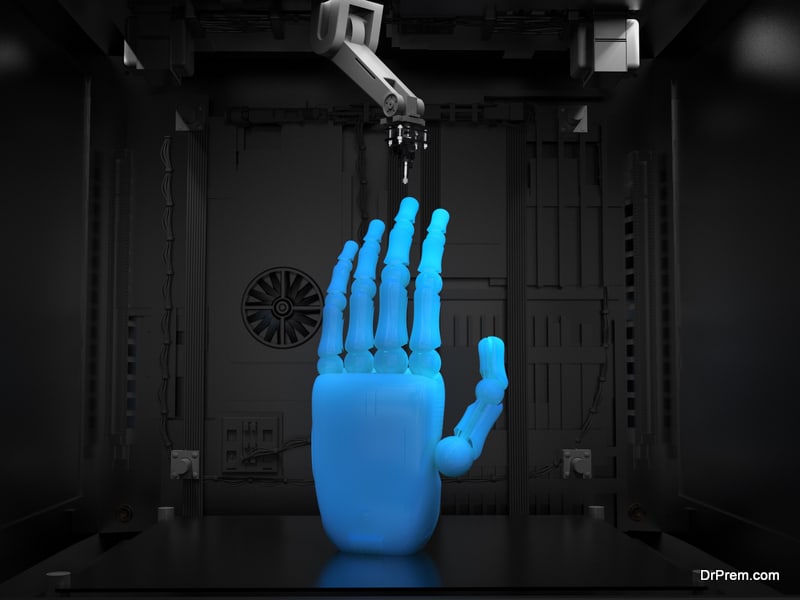If it is AI, Machine Learning, AR/VR creating waves in global healthcare, the coming years are poised to see more amazing tech innovations leading to remarkable transformations. The future is always unpredictable but futuristic inventions do help in catching a glimpse of how healthcare is shifting from the conventional reactive care to proactive care going much ahead in preventing the attack.
The following list is not exhaustive but is the anticipation of changes that are revolutionary in approach and application. Each of the innovations has its own special merit changing the care delivery model and health monitoring system remarkably improving treatment outcomes and patient experience.
30 Futuristic global healthcare tech innovations likely to rule this decade
-
30 futuristic global healthcare tech innovations to look out for:
-
Data from wearable would facilitate preventive medicine
-
In-silico clinical trials and simulation-based trials to stop testing on animals and human beings
-
Bionic eye
-
Beta cells from stem cells for diabetes cure
-
Cyborgs to create superhuman beings?
-
Contact lens for blood glucose monitoring
-
More targeted treatments with Nanotechnology
-
Deep reading health patch
-
Pacemakers to power your brain
-
Smart earbuds
-
Reading cancer with our eyes
-
Medical supplies delivered by drone
-
3-Printed Limbs
-
AI gets sharper in cancer-cell identification
-
Voice in healthcare diagnostics
-
Digital tattoos
-
Personalized prostate-cancer treatment
-
Pocket ultrasound
-
Mobile colposcope for cancer screening
-
Intelligent knife for advanced surgical oncology
-
Breathalyzers for cancer diagnosis
-
A highly diverse global bank for equitable personalized medicine
-
Robots for loneliness
-
3-D Digital hearts to reduce angioplasty and stent implantation
-
Blockchain bringing new promises to data privacy
-
3D Printed drugs
-
New Generation antibiotics
-
The wristband could be your mind reader
-
Advanced imaging technology for better diagnostics
-
Exoskeleton robots in paralysis treatment
30 futuristic global healthcare tech innovations to look out for:
1. Data from wearable would facilitate preventive medicine:
Ever since Fitbit created the healthcare wearable revolution, wearables have become ubiquitous generating volumes of data. According to the Stanford University School of Medicine, 2314 exabytes of data (1 exabyte= 1 billion Gigabytes) will be generated in 2020 which was 153 exabytes in 2013! With advanced sensor technologies, health can be assessed objectively which could detect early changes indicating the development of a disease and can be acted upon proactively.
2. In-silico clinical trials and simulation-based trials to stop testing on animals and human beings:
Not humans or animals but human-organs-on-chips would form the base of drug testing trials. Researchers of the Wyss Institute are working on microdevices lined with human cells. These can mimic the structure and functioning of human organs and can replace animals and human beings for trials.
Going a step forward, there would be no need of human cells too. Individualized computer simulation in the drug development and evaluation phase can perfectly chart the therapy, impact and function of the drug at a specific environment. FDA is looking forward to the future of clinical trial data evolving from computer simulations.
3. Bionic eye:
It is a further advancement of bionic prosthetics where surgical implantation of a prosthetic eye is done. It allows transduction of light that is transforming the external light to impulses which can be processed by the brain. This 3D-printed bionic prosthetic may not fully restore the vision but helps patients catch a glimpse of their environment.
4. Beta cells from stem cells for diabetes cure:
Millions across the globe suffering from Type 1 diabetes has to go through lifetime food and insulin injection management. The Harvard biologist, Doug Melton, however, thinks differently: using stem cells to create fresh beta cells for insulin production. Semma Therapeutics, a company co-founded by him, has created a small implantable device holding millions of beta cells that allow glucose and beta cells but leaves out insulin-immune cells.
5. Cyborgs to create superhuman beings?
Cyborg, the alternative term of a cybernetic organism means a human being having both organic and mechatronic body parts. Futuristic healthcare innovation not only implies restoring vision or movement with mechatronic devices but also to enhance the existing sensory powers. The growing use of AI-powered hearing aids, Multilanguage supporting earbuds and RFID chips point to that.
6. Contact lens for blood glucose monitoring:
No more painful finger-prick blood tests. South Korean researchers have come up with an innovative blood test mode with a contact lens. These flexible and transparent contact lenses will not obstruct your vision but will run wire-free glucose sensors to detect the blood glucose level from your tears.
7. More targeted treatments with Nanotechnology:
The dawn of nanomedicine is on the horizon. Nanodevices and tools would be soon used for more effective drug delivery, cancer treatments and high-precision surgeries. Max Planck Institute is working on mini or microsized robots that can swim through our bodies for targeted drug delivery. These nano-robots come as ingestible pills with sensors to track the digestion and absorption of drugs. In 2015, the FDA approved one such sensor-enabled ingestible drug product to treat mental illness.
8. Deep reading health patch:
Image Source : ucsdnews.ucsd.edu
Need to monitor your blood pressure and heartbeat regularly? No need of the digital BP machines. A small health patch, smaller than a postage stamp, will do the work for you. Ultrasonic waves emitted by the patch penetrate your skin tissues feeding your laptop with the blood pressure and heartbeat data.
9. Pacemakers to power your brain:
After the cardiac pacemakers, it is the turn of implanted electrodes in the brain to stimulate it further. Known as Deep Brain Stimulation, these brain pacemakers are effective in treating Obsessive Compulsive Disorders (OCD), Parkinson’s Diseases and even speed up stroke recovery process.
10. Smart earbuds:
Embedded sensors in hearing aids or earbuds will do a lot more apart from enhancing your hearing. It will count your heartbeat and movement. Furthermore, these will be integrated with a digital platform acting as a coach that will motivate a runner or extend assistance to a dementia patient.
11. Reading cancer with our eyes:
The color of your eye’s white would be able to detect cancer by seeing the signs of jaundice. An app in the development process at the University of Washington could identify elevated bilirubin levels by scanning a selfie (of the eye) of the person.
12. Medical supplies delivered by drone:
Drone delivery of medical supplies would be quite common in this decade. Flight Program, a pilot program conducted by UPS will be delivering critical medical supplies like blood and tissue between two hospitals in the US located not far away from each other. The effort is to expand the flight distance and cover more hospitals.
13. 3-Printed Limbs:
Creating perfectly socket-fitting artificial limbs are expensive even today. Many amputees don’t even get the right-fitting ones. 3D printing solutions and mobile phones bring a promising solution. These phones can take pictures of the residual limbs and send them to prosthetic professionals who with 3D printers can create the right-fit low-cost sockets and ship to the required person.
14. AI gets sharper in cancer-cell identification:
In a smart AI application, correctly spotting the cancer cells is the key to successful cancer treatment creating lesser toxic effects. The AI was trained to identify different forms of cancer in a sample which can be done in seconds. This has also helped in scheduling the drug dosage to minimize the side effects.
15. Voice in healthcare diagnostics:
Your voice can speak a lot about your health. Yes, apart from the stetho, BP machine and pathological tests, voice or vocal-biomarkers can prove very useful in detecting serious health risks. Voice analysis solutions and emotion analytics run on specifically designed algorithms can help in detecting CAD (Coronary Artery Diseases) or mental and psychological disorders.
16. Digital tattoos:
Groundbreaking advancements in 3D printing and circuit printing have enabled the creation of digital or electronic tattoos to be worn on the skin. These flexible tattoos fitted with small electrodes can record and transmit any health-related data of the wearer to smartphones and other connected devices that can be accessed by the healthcare experts.
They can track and diagnose critical conditions like abnormal heartbeat, brain activities, sleep disorders, risk of stroke, etc. without any invasive procedure. Although it will take some time to reach that stage, some promising solutions have entered the market.
17. Personalized prostate-cancer treatment:
High-grade prostate cancers can be lethal while moderate level ones can be managed by monitoring. Advanced research in Cleveland Clinic revealed a specific testosterone-based DNA anomaly in males that caused different responses to specific drugs. This paves a way for more personalized treatment of prostate cancer. In another research, an advanced blood test can detect prostate cancer more accurately than the existing ones.
18. Pocket ultrasound:
Image Source : assets.newatlas.com
Billions of people across the globe have no access to medical imaging services. Butterfly iQ, a go-anywhere pocket ultrasound device is aimed to serve this purpose. The ultrasound technology is wrapped up in the small chip and can be easily connected to an iphone App. Well, the device will not be as efficient and accurate as the conventional huge ultrasound machines but can go well with routine imaging services.
19. Mobile colposcope for cancer screening:
The year 2018 saw 570,000 fresh cervical cancer cases. Nearly 90% of cervical cancer deaths are from the lower economic strata of society. Improved screening and faster intervention can significantly reduce the death rate. EVA System, the battery-powered hand-held colposcope designed by MobileODT can take high-quality images of the cervix with more than 90% accuracy.
20. Intelligent knife for advanced surgical oncology:
Image Source : ichef.bbci.co.uk
Surgical oncology is one of the effective ways to beat cancer. In cancer surgery, the surrounding tissues along with the affected ones need to be removed but the risk of missing out cancerous cells remains. The iKnife tool tested by the Imperial College of London smartly scans the cancerous area leaving no chance of missing out any cancerous tissue reducing its probability of re-growth.
21. Breathalyzers for cancer diagnosis:
Breathalyzers would be having a new role in the medical domain that is in diagnosing cancer. Trials in Georgia Tech with a low-cost Breathalyzer device have been successful in detecting breast and lung cancer with 80% accuracy. This device can test about 75 volatile compounds characterizing this cancer and thus help in early diagnosis.
The immediate impact is, of course, a huge cost saving compared to $50,000 for biopsy and $4000 in PET scan. The next most significant benefit is its capability to detect early-stage lung cancer. Lung cancer, if detected at Stage 1 has a 70% cure rate. Unfortunately, most lung cancer cases get detected in Stage 3.
22. A highly diverse global bank for equitable personalized medicine:
The implementation of personalized medicine is hitting a roadblock. 80% of the human genome research databank comprises information of only Caucasian people, the minority population in the globe. This has created blank spaces in drug research. 54gene, a Nigeria-based startup is helping drug research and development by collecting genomic data from 54 different African countries to make personalized medicine more equitable especially in the lesser developed African nations.
23. Robots for loneliness:
Feeling lonely? No friends around? Meet Genie Connect, the miniature friend-robot, the tech companion to support you as a friend. Loneliness, according to medical professionals alone can increase the risk of many ailments including cardiovascular disease. GenieConnect’s bespoke features not only will smartly follow your commands but will also engage you in mind-stimulating things. If required, it can set up video conferences with your family members, remote friends, healthcare professionals and even remind you of your medication schedule and other appointments.
24. 3-D Digital hearts to reduce angioplasty and stent implantation:
Image Source : hfdc-corpweb.s3.amazonaws.com
Invasive procedures like angioplasty and stent implantation are common in treating blocked and narrowed arteries. Heartflow, initiated by a former professor of Stanford University, Charles Taylor allows specialists to have a 360° view of the personalized 3D heart models and consider different treatment approaches through on-screen 3D simulation which might prevent invasive procedures.
25. Blockchain bringing new promises to data privacy:
While Blockchain technology is abuzz for few years not many are aware of its operation and utility. However, it involves a complex code of trust-building between stakeholders eliminating the middleman. You can compare it with a record book or a shared database (among specified users) designed in a smart way that whatever data is added is immutable.
In healthcare data privacy protection, it holds a tremendous potential that not a single data can be changed or deleted without leaving any footprints. This ensures the security of patient data and clinical trials.
26. 3D Printed drugs:
Image Source : epilepsy.com
If there can be 3D-printed organs and prosthetics, then why not 3D-printed drugs? The FDA, in August 2015 approved 3D printing of the epilepsy drug Spritam. The powdered drug is printed out in layers with the help of 3D printers, for example, in the shape of Dinosaurs and Octopuses to make them dissolve faster than the normal pills. Commercialized 3D-printed pills are most likely to be available in the market in the next few years.
27. New Generation antibiotics:
How can we forget the novel contribution of Alexander Fleming in the field of antibiotics that saved countless lives? Now, these antibiotics have turned into killer drugs owing to growing antimicrobial resistance. Millions are developing fatal antimicrobial infections which are getting worse due to the decades-long gap in new unique antibiotic drug development.
But a new generation of drugs currently under clinical trials is set to change this threatening scenario. This class of drugs works in unique ways some of which can be considered as upgraded versions of existing antibiotics. These smart antibiotics target to kill specific disease-causing bacterial strains leaving other beneficial bugs in our body unharmed.
28. The wristband could be your mind reader:
Image Source : ctrl-labs.com
A grotesquely odd wristband keeps staring at a digital dinosaur. The wearer, unable to move, sends his brain signals to the digital dinosaur via the wristband making it work as he wishes to. The device on the wrist is a CTRL-kit that receives motor signals from the brain that passes through the arm no sooner than he thinks of a particular movement. This could be of immense help in rehabilitative treatments of persons affected with stroke, Parkinson’s, multiple sclerosis and other neurodegenerative conditions.
29. Advanced imaging technology for better diagnostics:
Patients will get diagnosed quickly and accurately with advanced radiology. Normally, X-Rays and MRI scans are common radiologic diagnostic procedures but the machines are gigantic and results are often ambiguous. Scientists are working on an advanced radiology machine that would come up with error-free medical data by instantly scanning the patient’s diseased area providing biomarkers and other symptoms.
30. Exoskeleton robots in paralysis treatment:
Image Source : ichef.bbci.co.uk
This is a unique form of robot that can be worn externally to aid in mobility. Aged and paralyzed people can use this exoskeleton-robot independently and walk or move as desired. These robots are programmed in a manner that will guide patients in their movement along with providing support. No additional human support will be required.








